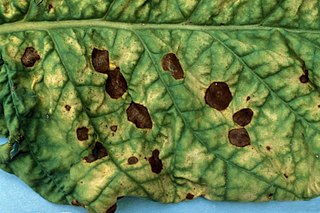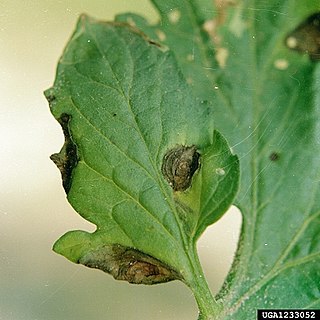Blight refers to a specific symptom affecting plants in response to infection by a pathogenic organism.

Withania somnifera, known commonly as ashwagandha or winter cherry, is an evergreen shrub in the Solanaceae or nightshade family that grows in India, the Middle East, and parts of Africa. Several other species in the genus Withania are morphologically similar.

Centaurea cineraria, the velvet centaurea, is also known as dusty miller and silver dust. Centaurea cineraria is in the family Asteraceae and is endemic to Italy. In natural settings, it grows on coastal cliffs, ranging from 0–350 m above sea level. Mature plants may reach 80 centimetres (31.5 in) in height. Centaurea cineraria produces purple flowers.

Alternaria is a genus of Deuteromycetes fungi. All species are known as major plant pathogens. They are also common allergens in humans, growing indoors and causing hay fever or hypersensitivity reactions that sometimes lead to asthma. They are present in the human mycobiome and readily cause opportunistic infections in immunocompromised people such as AIDS patients.

Alternaria alternata is a fungus causing leaf spots, rots, and blights on many plant parts, and other diseases. It is an opportunistic pathogen on over 380 host species of plant.

Alternaria brassicae is a plant pathogen able to infect most Brassica species including important crops such as broccoli, cabbage and oil seed rape. It causes damping off if infection occurs in younger plants and less severe leaf spot symptoms on infections of older plants.
Alternaria japonica is a fungal plant pathogen. It is a cause of black spot disease in cruciferous plants. It is not a major source of crop loss, but is considered dangerous for plants during the seedling stage.
Alternaria cucumerina is a fungal plant pathogen.
Alternaria dauci is a plant pathogen. The English name of the disease it incites is "carrot leaf blight".

Alternaria solani is a fungal pathogen that produces a disease in tomato and potato plants called early blight. The pathogen produces distinctive "bullseye" patterned leaf spots and can also cause stem lesions and fruit rot on tomato and tuber blight on potato. Despite the name "early," foliar symptoms usually occur on older leaves. If uncontrolled, early blight can cause significant yield reductions. Primary methods of controlling this disease include preventing long periods of wetness on leaf surfaces and applying fungicides. Early blight can also be caused by Alternaria tomatophila, which is more virulent on stems and leaves of tomato plants than Alternaria solani.
Alternaria dianthi, sometimes known as carnation blight, is a fungal pathogen of the genus Dianthus. Alternaria dianthi infections begin as small circular or ovular spots on leaves and stems, which can be red, purple, brown, yellow or gray.
Alternaria saponariae is a fungal plant pathogen.
Alternaria helianthi is a fungal plant pathogen causing a disease in sunflowers known as Alternaria blight of sunflower.

Napa cabbage is a type of Chinese cabbage originating near the Beijing region of China that is widely used in East Asian cuisine. Since the 20th century, it has also become a widespread crop in Europe, the Americas and Australia. In much of the world, it is referred to as "Chinese cabbage". In Australia it also is referred to as "wombok".

Ulocladium is a genus of fungi. Species of this genus contain both plant pathogens and food spoilage agents. Other species contain enzymes that are biological control agents. Some members of the genus can invade homes and are a sign of moisture because the mold requires water to thrive. They can cause plant diseases or hay fever and more serious infections in immuno-suppressed individuals.
Alternaria black spot of canola or grey leaf spot is an ascomycete fungal disease caused by a group of pathogens including: Alternaria brassicae, A. alternata and A. raphani. This pathogen is characterized by dark, sunken lesions of various size on all parts of the plant, including the leaves, stem, and pods. Its primary economic host is canola. In its early stages it only affects the plants slightly by reducing photosynthesis, however as the plant matures it can cause damage to the seeds and more, reducing oil yield as well.

Withania coagulans is a plant in the Solanaceae or nightshade family, native to Afghanistan, Pakistan and the Indian subcontinent. Within the genus Withania, W. somnifera (Ashwagandha) and W. coagulans are economically significant, and are cultivated in several regions for their use in Ayurveda. It is claimed to help control diabetes. The berries contain a rennet-like protease that can be used to clot milk for cheese production. The plant is prone to leaf spot disease caused by Alternaria alternata.
Alternaria tenuissima is a saprophytic fungus and opportunistic plant pathogen. It is cosmopolitan in distribution, and can colonize a wide range of plant hosts. Colonies of A. tenuissima produce chains on agar growth media. The fungus often forms concentric ring patterns on infected plant leaves. This species produces the allergen Alt a 1, one of the most important outdoor seasonal fungal allergens associated with allergy and asthma provocation. In rare circumstances, this species is also known to infect immunosuppressed humans and animals.

Alternaria brassicicola is a fungal necrotrophic plant pathogen that causes black spot disease on a wide range of hosts, particularly in the genus of Brassica, including a number of economically important crops such as cabbage, Chinese cabbage, cauliflower, oilseeds, broccoli and canola. Although mainly known as a significant plant pathogen, it also contributes to various respiratory allergic conditions such as asthma and rhinoconjunctivitis. Despite the presence of mating genes, no sexual reproductive stage has been reported for this fungus. In terms of geography, it is most likely to be found in tropical and sub-tropical regions, but also in places with high rain and humidity such as Poland. It has also been found in Taiwan and Israel. Its main mode of propagation is vegetative. The resulting conidia reside in the soil, air and water. These spores are extremely resilient and can overwinter on crop debris and overwintering herbaceous plants.

Alternaria leaf spot or Alternaria leaf blight are a group of fungal diseases in plants, that have a variety of hosts. The diseases infects common garden plants, such as cabbage, and are caused by several closely related species of fungi. Some of these fungal species target specific plants, while others have been known to target plant families. One commercially relevant plant genus that can be affected by Alternaria Leaf Spot is Brassica, as the cosmetic issues caused by symptomatic lesions can lead to rejection of crops by distributors and buyers. When certain crops such as cauliflower and broccoli are infected, the heads deteriorate and there is a complete loss of marketability. Secondary soft-rotting organisms can infect stored cabbage that has been affected by Alternaria Leaf Spot by entering through symptomatic lesions. Alternaria Leaf Spot diseases that affect Brassica species are caused by the pathogens Alternaria brassicae and Alternaria brassicicola.










